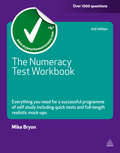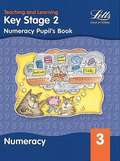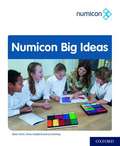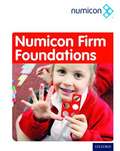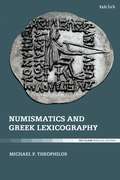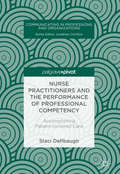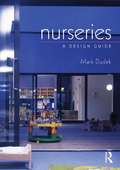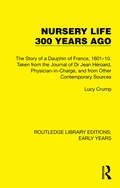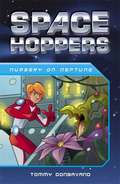- Table View
- List View
Numeracy for QTLS: Achieving the Minimum Core
by Liz Keeley-Browne Anne PriceBy 2010 the Government requires all teaching staff in the Lifelong Learning Sector to gain the QTLS (Qualified Teacher Learning and Skills) teaching qualification. In addition to the new qualification, all those training to teach in the post compulsory/FE sector must also have reached an acceptable skill level in literacy, numeracy and ICT before they qualify, this is referred to as 'the minimum core' and states that literacy skills must be equivalent to a level 3 qualification (A Level standard) and numeracy skills must be equivalent to level 2 (GSCE). This aims to be the first core textbook in the market to support those undertaking initial teacher training in the post-compulsory/learning and skills sector (formerly FE). The text is structured in line with the requirements and specifications of the minimum core and therefore guides students to achieve the minimum core and pass the new national tests in order to achieve their QTLS qualification. This is achieved by developing the student's personal knowledge, skills, and strategies in order to ensure that they support their own students when they start teaching/training themselves. In addition a self-audit of numeracy skills is available online in order to identify areas of personal strengths and weakness.
Numeracy for Teaching
by Derek Haylock`Comprises a very helpful resource for students who are obliged to succeed in passing the QTS numeracy test in order to gain QTS. It should provide a valuable resource for students to increase their confidence as well as their competence' - Mathematics in Schools `The stated aim of this book is to help teacher-trainees prepare for the numeracy test all new entrants to the profession now have to pass. Any trainee worried about the test should find this a useful resource…. As in similar books by Derek Haylock, the mathematical content is written in a clear and accessible style' - Mike Askew, Times Educational Supplement Quotes from the author's students `The book is excellent. I think it will present students and others with a valuable resource, not only to help with the QTS test, but also for teaching. I could see myself using it on "dip-in-as-necessary" basis'. `The practice questions were really helpful for checking and consolidating learning. The material was useful for the QTS test, particularly the mental calculations. Many thanks for letting me work through your sample material. I cannot begin to tell you how much more I have learnt! This has definitely made me feel more confident about passing the QTS numeracy skills test! I have definitely demonstrated to myself from this material that my ability to complete calculations mentally has increased. I can calculate faster and with some accuracy now!' `Comprises a very helpful resource for students who are obliged to succeed in passing the QTS numeracy test in order to gain QTS. It should provide a valuable resource for students to increase their confidence as well as their competence' - Mathemtics in Schools This book is designed to help teacher-trainees prepare for the Qualified Teaching Standards numeracy test that must now be passed by all entrants to the teaching profession. The author focuses especially on weaknesses in numeracy often observed in adults, and in teacher-trainees in particular. As far as possible, this mathematics is set in the professional context of teaching, drawing on statistics and other data from individual schools, the DfEE and the Qualifications and Curriculum Agency (QCA).
Numeracy for Teaching (PDF)
by Derek Haylock`Comprises a very helpful resource for students who are obliged to succeed in passing the QTS numeracy test in order to gain QTS. It should provide a valuable resource for students to increase their confidence as well as their competence' - Mathematics in Schools `The stated aim of this book is to help teacher-trainees prepare for the numeracy test all new entrants to the profession now have to pass. Any trainee worried about the test should find this a useful resource…. As in similar books by Derek Haylock, the mathematical content is written in a clear and accessible style' - Mike Askew, Times Educational Supplement Quotes from the author's students `The book is excellent. I think it will present students and others with a valuable resource, not only to help with the QTS test, but also for teaching. I could see myself using it on "dip-in-as-necessary" basis'. `The practice questions were really helpful for checking and consolidating learning. The material was useful for the QTS test, particularly the mental calculations. Many thanks for letting me work through your sample material. I cannot begin to tell you how much more I have learnt! This has definitely made me feel more confident about passing the QTS numeracy skills test! I have definitely demonstrated to myself from this material that my ability to complete calculations mentally has increased. I can calculate faster and with some accuracy now!' `Comprises a very helpful resource for students who are obliged to succeed in passing the QTS numeracy test in order to gain QTS. It should provide a valuable resource for students to increase their confidence as well as their competence' - Mathemtics in Schools This book is designed to help teacher-trainees prepare for the Qualified Teaching Standards numeracy test that must now be passed by all entrants to the teaching profession. The author focuses especially on weaknesses in numeracy often observed in adults, and in teacher-trainees in particular. As far as possible, this mathematics is set in the professional context of teaching, drawing on statistics and other data from individual schools, the DfEE and the Qualifications and Curriculum Agency (QCA).
Numeracy in Authentic Contexts: Making Meaning Across the Curriculum
by Maura SellarsThis book is based on the notion that there are many ways in which mathematics learning can be achieved for students and that not all of them are focused on the mathematics classroom. It explores the foundational numeracy principles of the non-mathematical subject areas and aligns these to the Australian numeracy-learning continuum. It demonstrates, in detail, the extent to which numeracy competencies underpin successful learning in all the subject areas of the curricula. It validates a focus of developing numeracy competencies through learning in the arts, science and other discipline areas with which school students to engage with in order develop holistically, but which are not subjected to national assessment practices. It is developed around the notion of ‘praxis’, putting theory into practice in order to respond to the urgent need for students to be supported in their efforts to increase their numeracy capabilities in a world where extensive amounts of new information are often presented in graphical or data based formats. Additionally, it offers perspectives on developing all students’ capacities to become numerate in school contexts and presents inclusive, differentiated lesson examples as an alternative way of exploring numeracy in the context of teaching and learning in real-world classroom contexts.
The Numeracy Test Workbook: Everything You Need for a Successful Programme of Self Study Including Quick Tests and Full-length Realistic Mock-ups (Testing Series)
by Mike BryonNumeracy, or numerical reasoning tests are one of the most common types of psychometric tests used in assessment and selection procedures, and now with increased competition for jobs and placements it has never been more important to excel in them.This second edition of The Numeracy Test Workbook includes over 1000 questions and is the perfect starting point if you lack practice or confidence. It gives you the opportunity to improve your numerical skills before facing a real-life test. It will help you get up to speed on the basic skills needed for multiplication, division, fractions, percentages and units of measurement. The section on key skills is followed by practice questions and realistic mock tests, organized into number problems, number sequencing and data interpretation.Now including time-based questions which are used in the selection of emergency services staff, this companion to the popular How to Pass Numeracy Tests also includes detailed explanations to answers and interpretations of scores. It will help you to improve your test techniques and dramatically increase your chances of success.
The Numeracy Test Workbook: Everything You Need for a Successful Programme of Self Study Including Quick Tests and Full-length Realistic Mock-ups (Testing Series)
by Mike BryonNumeracy, or numerical reasoning tests are one of the most common types of psychometric tests used in assessment and selection procedures, and now with increased competition for jobs and placements it has never been more important to excel in them.This second edition of The Numeracy Test Workbook includes over 1000 questions and is the perfect starting point if you lack practice or confidence. It gives you the opportunity to improve your numerical skills before facing a real-life test. It will help you get up to speed on the basic skills needed for multiplication, division, fractions, percentages and units of measurement. The section on key skills is followed by practice questions and realistic mock tests, organized into number problems, number sequencing and data interpretation.Now including time-based questions which are used in the selection of emergency services staff, this companion to the popular How to Pass Numeracy Tests also includes detailed explanations to answers and interpretations of scores. It will help you to improve your test techniques and dramatically increase your chances of success.
Numeracy Year 3: Pupil's Book (PDF)
by Peter Patilla Paul BroadbentA Key Stage one numeracy pupil's textbook for Year three containing differentiated material and complete coverage of the National Numeracy Framework.
Numerische Strömungssimulation in der Hydrodynamik: Grundlagen und Methoden
by Helmut MartinDer Band liefert eine Einführung in die numerische Strömungssimulation im Bau- und Wasserwesen. Nach einem Überblick über die Methoden werden in Teil 1 Grundlagen und Grundgleichungen der Strömungsmechanik formuliert. In Teil 2 werden ausgewählte Methoden wie die Finite-Element-Methode, das Galerkin-Verfahren, die Finite-Volumen- und Finite-Element-Methode anhand von Beispielen aus der Hydrodynamik erläutert. Vier Programme, mit denen Beispiele im Buch bearbeitet werden können, stehen Lesern unter http://extras.springer.com zur Verfügung.
Numicon: Breakng Barriers Assessment and Photocopy Masters (PDF)
by Tony Wing Romey Tacon Ruth AtkinsonNumicon is a proven approach for teaching and learning maths that builds deep understanding and engagement. Through active investigation with problem-solving at its heart and supported by structured apparatus, children reason and communicate mathematically with confidence. Breaking Barriers is specifically designed for teaching children who experience particular difficulties learning maths, including those with special educational needsanddisabilities. The Assessment and Photocopy Masters book contains Assessment Signposts for ensuring that teaching starts at an appropriate point, an Individual Record of Progress providing detailed trackingfor each child, a Child Profile for building a picture of strengths and difficulties so that specific needs can be addressed, and Photocopy masters to support the activities in the Teaching Handbook.
Numicon: Big Ideas
by Steve Chinn Fiona Goddard Liz HenningNumicon Big Ideas is a programme of additional sessions for small groups, focusing on key elements of the Primary maths curriculum for pupils not meeting age-related expectations in Upper Key Stage 2 or Key Stage 3 (aged 10 upwards), and laying the foundation for success at Secondary level as well as in end-of-Primary assessments.
Numicon Firm Foundations (PDF)
by Ruth Atkinson Romey Tacon Rachel Hussain Tony WingThe Numicon Firm Foundations Teaching Pack provides a comprehensive and varied programme of mathematics activities for children aged 3-5, with planning and assessment support, photocopy masters, expert guidance on the key mathematical ideas children will meet, and advice on how to put the Numicon approach into practice.
Numismatics and Greek Lexicography
by Michael P. TheophilosMichael P. Theophilos explores the fascinating variety of numismatic contributions to Greek lexicography, pertaining to lexicographic studies of the Second Temple period in general, and the New Testament in particular. Theophilos considers previous scholarly attempts to grapple with, and incorporate, critical numismatic material into the emerging discipline of Greek lexicography - including foundational work by F. Preisigke and E. Kiessling - before outlining his own methodological approach. Theophilos' then examines the resources available for engaging with the numismatic material, and presents a series of specific case studies throughout the New Testament material. His carefully annotated images of coins draw readers in to a greater understanding of the material culture of the Greco-Roman world, and how this impacted upon the Greek language and the New Testament.
Numismatics and Greek Lexicography
by Michael P. TheophilosMichael P. Theophilos explores the fascinating variety of numismatic contributions to Greek lexicography, pertaining to lexicographic studies of the Second Temple period in general, and the New Testament in particular. Theophilos considers previous scholarly attempts to grapple with, and incorporate, critical numismatic material into the emerging discipline of Greek lexicography - including foundational work by F. Preisigke and E. Kiessling - before outlining his own methodological approach. Theophilos' then examines the resources available for engaging with the numismatic material, and presents a series of specific case studies throughout the New Testament material. His carefully annotated images of coins draw readers in to a greater understanding of the material culture of the Greco-Roman world, and how this impacted upon the Greek language and the New Testament.
Nurse Educator's Guide to Best Teaching Practice: A Case-Based Approach
by Keeley C. Harmon Joe Ann Clark Jeffery M. Dyck Vicki MoranThis book presents essential teaching skills and tools for nurse educators. It begins with a discussion of the trends in nursing education and the principles of teaching and learning. The book then explores topics such as classroom teaching, clinical experiences, teaching in the simulation laboratory, and online learning. Each chapter discusses the basics of teaching and learning in the specific environment, followed by scenarios that focus on the issues encountered by nursing faculty in these settings. The scenarios present the key issues under consideration, recommend actions that faculty members can institute to address the issues, and describe rationales and solutions based on best evidence. The book also includes specific tools designed to assist nurse educators in preparation for the teaching role, such as examples of course syllabi, program outcomes, clinical contracts, and action plans. Nurse Educator’s Guide to Best Teaching Practice is a valuable resource for novice and experienced educators in managing the challenges inherent in nursing education.
Nurse Practitioners and the Performance of Professional Competency: Accomplishing Patient-centered Care
by Staci DefibaughThis book examines the interactional practices of nurse practitioners (NPs) and the delivery of health care in the US. The author takes a discourse analytic approach, examining the linguistic resources that NPs employ in their interactions with patients. These linguistic features are connected to the concept of professional competency with specific focus on the enactment of the patient-centered approach. Analytic focus is placed on how NPs address organizational responsibilities during medical visits with patients, the form and function of patient education, the use of indirect speech, and the role that small talk plays in health care encounters. The book explores the understudied professional field of nurse practitioners and examines their linguistic practices with an eye on crossing disciplinary boundaries, integrating research from linguistics, discourse analysis and health communication. It will appeal to those interested in medical discourse analysis and health communication, as well as applied linguistics scholars.
Nurse Practitioners and the Performance of Professional Competency: Accomplishing Patient-centered Care (Communicating in Professions and Organizations)
by Staci DefibaughThis book examines the interactional practices of nurse practitioners (NPs) and the delivery of health care in the US. The author takes a discourse analytic approach, examining the linguistic resources that NPs employ in their interactions with patients. These linguistic features are connected to the concept of professional competency with specific focus on the enactment of the patient-centered approach. Analytic focus is placed on how NPs address organizational responsibilities during medical visits with patients, the form and function of patient education, the use of indirect speech, and the role that small talk plays in health care encounters. The book explores the understudied professional field of nurse practitioners and examines their linguistic practices with an eye on crossing disciplinary boundaries, integrating research from linguistics, discourse analysis and health communication. It will appeal to those interested in medical discourse analysis and health communication, as well as applied linguistics scholars.
Nurseries: A Design Guide
by Mark DudekArchitecture can inspire young children; the very shape and form of a daycare center can not only stimulate their imagination but can help children form strong relationships and help promote development. This design guide presents all the elements of building design that combine to create the very best environment for young children and the people who work with them, including building materials, multi-functional spaces and design scaled to suit small children.
Nurseries: A Design Guide
by Mark DudekArchitecture can inspire young children; the very shape and form of a daycare center can not only stimulate their imagination but can help children form strong relationships and help promote development. This design guide presents all the elements of building design that combine to create the very best environment for young children and the people who work with them, including building materials, multi-functional spaces and design scaled to suit small children.
Nursery Life 300 Years Ago: The Story of a Dauphin of France, 1601–10. Taken from the Journal of Dr Jean Héroard, Physician-in-Charge, and from Other Contemporary Sources (Routledge Library Editions: Early Years)
by Lucy CrumpOriginally published in 1929, Nursery Life 300 Years Ago is about the childhood of a seventeenth-century Dauphin of France, taken from the journal of Dr. Jean Heìroard, physician-in-charge and other contemporary sources, which is used as a medium for describing the education, toys and other social aspects of childhood at that time. A fascinating glimpse into the historic study of children.
Nursery Life 300 Years Ago: The Story of a Dauphin of France, 1601–10. Taken from the Journal of Dr Jean Héroard, Physician-in-Charge, and from Other Contemporary Sources (Routledge Library Editions: Early Years)
by Lucy CrumpOriginally published in 1929, Nursery Life 300 Years Ago is about the childhood of a seventeenth-century Dauphin of France, taken from the journal of Dr. Jean Heìroard, physician-in-charge and other contemporary sources, which is used as a medium for describing the education, toys and other social aspects of childhood at that time. A fascinating glimpse into the historic study of children.
Nursery Nurse to Early Years’ Practitioner: Role, Relationships and Responsibilities
by Hazel G. WhittersThe role, relationships and responsibilities of the traditional ‘nursery nurse’ have changed markedly within the last 20 years, demanding a high level of skill, knowledge and understanding which pertains to formal international standards. This book responds to the needs of a workforce who have experienced rapid developments and challenges. It supports an understanding of ‘self’ and the creation of an organisational pedagogy. Concepts are explored by reference to research indicating the importance of relationship-based practice with children and parents. Experienced practitioner Hazel Whitters draws on practical examples from the field, such as attachment, inclusion, pedagogy and child protection to bridge the implementation gap between current research, policy and practice of work in the early years. Nursery Nurse to Early Years’ Practitioner will be of interest to early years' practitioners, academics, post-graduate students, researchers and course leaders in the field.
Nursery Nurse to Early Years’ Practitioner: Role, Relationships and Responsibilities
by Hazel G. WhittersThe role, relationships and responsibilities of the traditional ‘nursery nurse’ have changed markedly within the last 20 years, demanding a high level of skill, knowledge and understanding which pertains to formal international standards. This book responds to the needs of a workforce who have experienced rapid developments and challenges. It supports an understanding of ‘self’ and the creation of an organisational pedagogy. Concepts are explored by reference to research indicating the importance of relationship-based practice with children and parents. Experienced practitioner Hazel Whitters draws on practical examples from the field, such as attachment, inclusion, pedagogy and child protection to bridge the implementation gap between current research, policy and practice of work in the early years. Nursery Nurse to Early Years’ Practitioner will be of interest to early years' practitioners, academics, post-graduate students, researchers and course leaders in the field.
The Nursery Year in Action: Following children’s interests through the year
by Anna EphgraveChild-led learning in the early years allows children to thrive while making accelerated progress. Young children learn and develop best when they are in a stimulating environment which is carefully organised and equipped to meet their needs, interests and stages of development, and where each child’s progress is carefully observed, managed and enhanced by adults who engage and interact with them to support them in making outstanding progress. Demonstrating how a child-led approach supports the development of purposeful, calm, confident and independent children, The Nursery Year in Action offers a unique month-by-month overview of the workings of an outstanding Nursery setting. The book covers all aspects of practice from the organisation of the classroom and garden and the rationale behind this to the routines and boundaries that ensure children are safe, happy and therefore able to explore and learn. It tracks the events of each month in the year paying particular attention to the environment, the role of the adult, links with parents, children’s individual needs and the key areas of learning and development. Throughout the book Anna Ephgrave gives the reason behind each decision and shows what the outcomes have been for the children, emphasising that a child-led approach, with planning in the moment can meet the requirements of the revised Early Years Foundation Stage and the individual needs of the children. Key features include: Over 150 full colour photographs to illustrate practice Photocopiable pages of planning sheets, record keeping sheets, sample letters to parents and play resources also available for download List of resources and materials Examples of individual learning journeys and planning in the moment for groups Guidance on what to look for when assessing children’s progress Advice on risk/benefit assessments Suggestions for managing transitions and minimising stress Written by a leading consultant teacher whose Early Years’ department has achieved "Outstanding" at four consecutive Ofsted inspections, this book provides practitioners with the practical ideas to work with confidence in a way that is rewarding, manageable and, above all, creates a happy, relaxed learning environment for children.
The Nursery Year in Action: Following children’s interests through the year
by Anna EphgraveChild-led learning in the early years allows children to thrive while making accelerated progress. Young children learn and develop best when they are in a stimulating environment which is carefully organised and equipped to meet their needs, interests and stages of development, and where each child’s progress is carefully observed, managed and enhanced by adults who engage and interact with them to support them in making outstanding progress. Demonstrating how a child-led approach supports the development of purposeful, calm, confident and independent children, The Nursery Year in Action offers a unique month-by-month overview of the workings of an outstanding Nursery setting. The book covers all aspects of practice from the organisation of the classroom and garden and the rationale behind this to the routines and boundaries that ensure children are safe, happy and therefore able to explore and learn. It tracks the events of each month in the year paying particular attention to the environment, the role of the adult, links with parents, children’s individual needs and the key areas of learning and development. Throughout the book Anna Ephgrave gives the reason behind each decision and shows what the outcomes have been for the children, emphasising that a child-led approach, with planning in the moment can meet the requirements of the revised Early Years Foundation Stage and the individual needs of the children. Key features include: Over 150 full colour photographs to illustrate practice Photocopiable pages of planning sheets, record keeping sheets, sample letters to parents and play resources also available for download List of resources and materials Examples of individual learning journeys and planning in the moment for groups Guidance on what to look for when assessing children’s progress Advice on risk/benefit assessments Suggestions for managing transitions and minimising stress Written by a leading consultant teacher whose Early Years’ department has achieved "Outstanding" at four consecutive Ofsted inspections, this book provides practitioners with the practical ideas to work with confidence in a way that is rewarding, manageable and, above all, creates a happy, relaxed learning environment for children.




